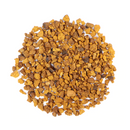Description
*Uses:
The antioxidant activity of polysaccharides (beta-glucans) contained in chaga help maintain cell integrity and fight free radicals. Chaga is used in traditional Russian Folk Medicine and Traditional Chinese Medicine to support gastrointestinal health, and as a tonic to support overall health*
Chaga is a fungus, a parasitic carpophore that looks like the charred remains of burned wood on the side of a birch tree (sometimes growing on Elm and Alder, but Birch is its favorite). It is not the fruiting body of the fungus, but a sclerotia or mass of mycelium. The parasite enters the tree through a 'wound' in the bark of a mature tree. It then grows under the bark until it erupts in a deeply cracked, black charcoal like extension. It usually takes another 5-7 years for it to fully mature, at which point it falls to the forest floor, most times killing the host tree in the process.
Chaga supports immune health to help you stay feeling your best and supports the body’s immune defenses to stay feeling healthy*
Chaga is typically and historically ingested as a tea, but it also has been made into a tincture, and less commonly into powder that is then used as a tea; Encapsulation seems to be rare. There have been reports of it being the base for liqueurs and as a substitute for hops in beer. In Russia, it can be found as a syrup, a tablet, an aerosol, and even as a suppository. If you are using the cut chaga for the purpose of making a tea, you can re-brew your material a second time without loss to flavor or potency. Our chaga includes the entire sclerotia. Our organic chaga mushrooms can be decocted into chaga tea and incorporated into broths and soups.
Qualities:
Chaga is a parasitic fungus that resembles charred wood and thrives primarily on birch trees, although it can occasionally be found on elm and alder. This unique sclerotia takes 5-7 years to mature and often causes the eventual demise of its host tree. Our organic chaga includes the entire sclerotia to ensure maximum benefit.
How to Use:
Chaga is traditionally prepared as a tea but can also be made into tinctures or incorporated into broths and soups. It has even been used in creative ways, such as in liqueurs, as a hops substitute in beer, or processed into syrups, tablets, aerosols, and suppositories. When brewing tea, the same material can be reused a second time without compromising flavor or potency.
Precautions
No known precautions. We recommend that you consult with a qualified healthcare practitioner before using herbal products, particularly if you are pregnant, nursing, or on any medications.
THIS HERB SOLD BY THE OZ


